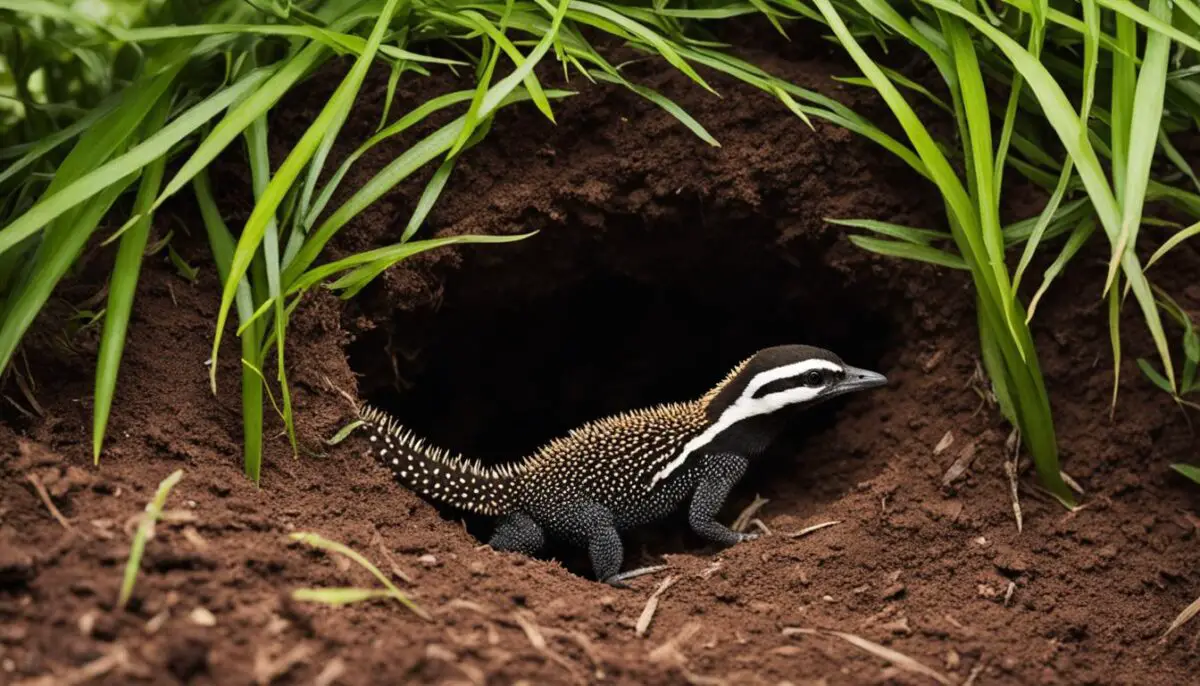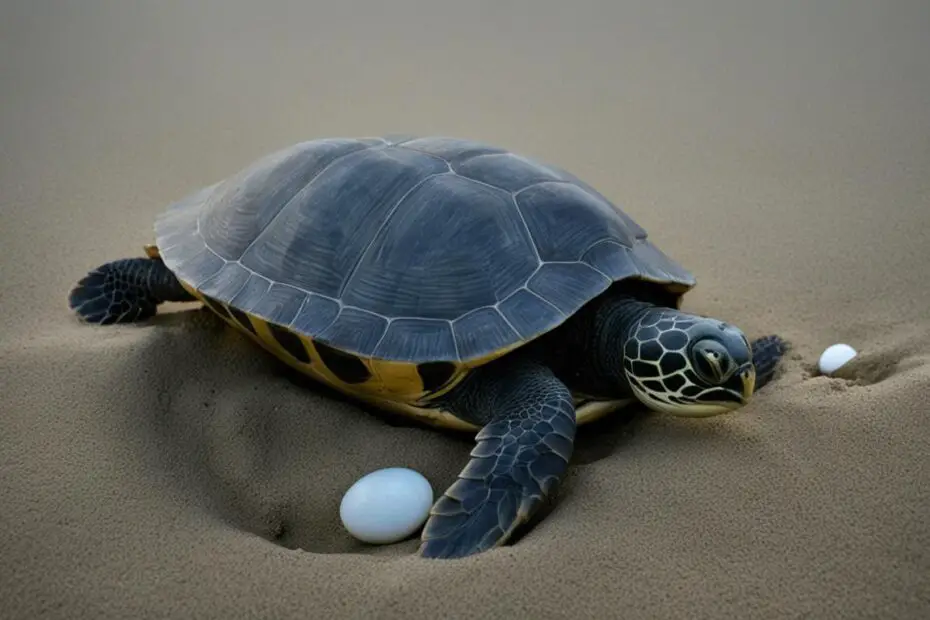When we think of animals that lay eggs, birds may be the first to come to mind. However, the animal kingdom is teeming with a fascinating array of non-bird egg-laying creatures. From fishes and amphibians to reptiles, insects, and even mammals, the diversity of animals that lay eggs is truly remarkable.
One such group of egg-laying mammals is the monotremes, which includes unique creatures like the platypus and the enigmatic echidna. These extraordinary animals defy the norm by laying eggs and then nourishing their young ones with milk.
Meanwhile, in the underwater world, fishes lay eggs of various sizes and types. Some have hard shells, while others boast softer, leathery exteriors. The egg-laying process for fishes is a fascinating aspect of their life cycle that takes place in different habitats, including freshwater rivers and lakes, as well as the vast ocean.
Key Takeaways:
- Animals that lay eggs extend beyond birds and include fishes, amphibians, reptiles, insects, and even mammals like monotremes.
- Fishes lay eggs in various shapes, sizes, and habitats, ranging from those with hard shells to those with softer, leathery exteriors.
- Monotremes, such as the platypus and echidna, are the only mammals that lay eggs and then feed their young with milk.
Fishes
Fishes are fascinating creatures that belong to the diverse group of animals known for laying eggs. Their eggs come in various types, each with its own unique characteristics. Some fish eggs are transparent or translucent, while others exhibit vibrant colors that capture the eye. Let’s explore the different types of fish eggs:
Adhesive Eggs
Adhesive fish eggs, as the name suggests, have the remarkable ability to stick to various surfaces. These eggs usually attach themselves to rocks, aquatic plants, or even artificial structures like piers or shipwrecks. The adhesive nature of these eggs provides protection from predators and ensures the eggs remain in a secure location for optimal development.
Floating Eggs
Unlike adhesive eggs, some fish species produce eggs that float freely in the water. These eggs do not attach to any surface and rely on ocean currents or water movements to carry them to favorable locations. Floating eggs can be found in different habitats, including freshwater rivers and lakes as well as the vast expanse of the ocean.
Nest-Building Fish
There are fish species that exhibit nesting behaviors, where the male creates a nest and the female lays her eggs in it. These nests can be made from various materials like pebbles, shells, or plants. The male fish diligently guards the nest, ensuring the safety of the eggs until they hatch. This nest-building behavior is an amazing example of parental care in the underwater world.
With their diverse range of eggs and fascinating reproductive strategies, fishes contribute to the incredible biodiversity that exists in our oceans, rivers, and lakes. The egg-laying process in fishes is a testament to the wonders of nature and the remarkable adaptations that have evolved over millions of years.

The Life Cycle of Frogs
- Egg Stage: Female frogs lay their eggs in water.
- Tadpole Stage: The eggs hatch into tadpoles, which develop in the water.
- Metamorphosis: Tadpoles undergo a transformation process called metamorphosis, during which they develop legs and lungs.
- Adult Stage: Once fully developed, the tadpoles transform into terrestrial adult frogs.
Understanding the process of amphibians, such as frogs and toads, laying eggs provides valuable insights into the complexity of the animal kingdom and the various reproductive strategies that exist.
Reptiles
Reptiles, including crocodiles, alligators, turtles, snakes, and lizards, are well-known for their egg-laying capabilities. These fascinating creatures have developed a unique and intricate process of reproducing through the laying of eggs. Let’s explore the reptile egg-laying process and discover some intriguing facts about each reptilian group.
Crocodiles and Alligators
Crocodiles and alligators are powerful and ancient reptiles that have been around for millions of years. These impressive creatures lay their eggs in nests built on riverbanks or in vegetation near water bodies. The mother carefully guards the nest, ensuring the eggs remain safe from predators. Crocodile eggs typically hatch after about 80 days, while alligator eggs may take up to 70 days to hatch.
Turtles
Turtles have a remarkable nesting process. Female turtles come ashore to lay their eggs on sandy beaches, digging deep holes with their hind flippers to create a nest. They then deposit their eggs and cover them with sand before returning to the ocean. The eggs are left to incubate under the warm sand, ensuring the safe development of the baby turtles. Depending on the species, it may take several weeks to several months for the eggs to hatch.
Snakes
Snakes, known for their sleek and slithering movements, also rely on egg-laying to reproduce. Female snakes produce eggs that develop and hatch outside their bodies. Different snake species exhibit varied nesting behaviors. Some snakes find secure hiding spots in underground burrows or tree hollows to lay their eggs, while others may deposit their eggs in compost heaps or beneath rocks. The incubation period for snake eggs ranges from several weeks to several months.
Lizards
Lizards, with their scaly skin and diverse habitats, encompass a wide range of egg-laying strategies. Some lizards, like the Komodo dragon, construct nests to protect their eggs, while others simply dig shallow holes in the ground. The female lizard then deposits her eggs in the nesting area and covers them with soil or sand. The incubation period varies depending on the species but can last from a few weeks to several months.
Reptiles, with their remarkable ability to lay eggs, have adapted to various environments and developed unique nesting behaviors to ensure the survival of their offspring. Let’s take a closer look at their egg-laying process and nesting behaviors in the table below:
| Reptile | Nesting Behavior | Incubation Period |
|---|---|---|
| Crocodiles | Build nests on riverbanks or in vegetation near water bodies | Around 80 days |
| Alligators | Construct nests on riverbanks or in vegetation near water bodies | Up to 70 days |
| Turtles | Lay eggs in sandy beaches and cover them with sand | Several weeks to several months |
| Snakes | Find secure hiding spots to lay eggs | Several weeks to several months |
| Lizards | Construct nests or dig shallow holes in the ground | Varies depending on the species |

Monotremes, such as the platypus and the echidna, challenge our understanding of mammalian reproduction and provide valuable insights into the evolutionary history of these remarkable creatures.
Birds and Other Animals
Birds, ostriches, hornbills, and hummingbirds are among the many animals that lay eggs. While birds are exclusively oviparous, meaning they all lay eggs, the size and characteristics of their eggs vary greatly.
Ostriches
Ostriches lay the largest eggs of any bird species. These eggs are quite impressive in size, with an average weight of about 3 pounds (1.4 kilograms) and a length of 6 inches (15 centimeters). Their size is a result of the unique demands of the ostrich’s biology, as they require a sturdy shell to support the incubation process.
Hornbills
Hornbills exemplify fascinating nesting behaviors among egg-laying birds. The female hornbill seals herself inside the nest cavity using a mixture of mud and her own feces, leaving only a small slit for the male to pass her food while she incubates the eggs. This behavior provides protection for the female and her young, ensuring their safety from predators.
Hummingbirds
On the opposite end of the spectrum, hummingbirds lay the smallest eggs of any bird species. These tiny eggs, about the size of a jelly bean, measure less than half an inch (1 centimeter) in length. Despite their diminutive size, these eggs contain all the necessary components for the development of hummingbird chicks, including the yolk, albumen, and protective shell.
Fish, reptiles, amphibians, corals, and invertebrates are also examples of animals that lay eggs, contributing to the incredible diversity of egg-laying species across the animal kingdom.
| Animal | Characteristic |
|---|---|
| Fish | Wide variety of egg shapes and sizes |
| Reptiles | Eggs laid in various nesting environments |
| Amphibians | Eggs laid in water, often attached to vegetation |
| Corals | Eggs released into the water to undergo fertilization |
| Invertebrates | Eggs with diverse forms and reproductive strategies |
Understanding the diverse array of animals that lay eggs broadens our appreciation for the incredible adaptations and reproductive strategies found throughout the animal kingdom.
**Note**: Please note that the table provided above is not complete and is only meant to serve as an example. The complete table should have more rows and detailed information about each category of animals that lay eggs.
Conclusion
The world of animals that lay eggs is incredibly diverse and fascinating. From fishes to amphibians, reptiles, and even mammals, this reproductive strategy is widespread throughout the animal kingdom. Understanding the different types of egg-laying animals and their unique egg-laying processes helps us appreciate the incredible diversity and complexity of life on Earth.
Protecting these animals and their habitats is of utmost importance in ensuring their survival and maintaining the delicate balance of our ecosystems. By preserving their natural habitats, we can provide them with the necessary conditions for reproduction and growth. Additionally, implementing conservation measures and raising awareness about the importance of these animals helps to safeguard their future.
Together, we can make a difference in the lives of these remarkable creatures. By appreciating and protecting the world of animals that lay eggs, we contribute to the preservation of our planet’s biodiversity and the intricate web of life that sustains us all.
FAQ
What types of animals lay eggs besides birds?
Animals that lay eggs include fishes, amphibians, reptiles, mammals, and other non-avian creatures. Examples of egg-laying animals include frogs, toads, crocodiles, turtles, snakes, lizards, platypus, and echidna. Even some insects, corals, and invertebrates lay eggs.
Do all fish lay eggs?
Yes, all fish lay eggs. Fish eggs can vary in appearance, from transparent or translucent to colorful and vibrant. The eggs can be found in freshwater rivers, lakes, as well as in the ocean. Fishes exhibit different egg-laying behaviors, such as adhesive eggs, floating eggs, and nest-building fish that care for their eggs.
How do amphibians lay their eggs?
Amphibians, like frogs and toads, lay their eggs in water. Frogs lay their eggs in clusters, often attached to vegetation or floating debris in ponds, lakes, or other bodies of water. The female frogs lay a large number of eggs to compensate for the high mortality rate during development.
Which reptiles lay eggs?
Reptiles, including crocodiles, alligators, turtles, snakes, and lizards, lay eggs. These reptiles construct nests and lay their eggs in various environments, such as on land, in underground burrows, or in sand. The temperature during incubation can impact the sex of the reptile offspring.
Are there mammals that lay eggs?
Yes, there are mammals that lay eggs. These unique mammals are known as monotremes and include the platypus and echidna. Monotremes lay eggs and then feed their young with milk after hatching. This combination of egg-laying and milk production is exclusive to monotremes.
Besides birds, what other animals lay eggs?
In addition to birds, other animals that lay eggs include ostriches, hornbills, hummingbirds, fish, reptiles, amphibians, corals, and various invertebrates. Ostriches lay the largest eggs of any bird species, while hornbills exhibit unique nesting behaviors. Hummingbirds, fish, reptiles, amphibians, corals, and invertebrates also have diverse egg-laying mechanisms.
Why is it important to protect egg-laying animals and their habitats?
The world of animals that lay eggs is diverse and fascinating. Understanding the different types of egg-laying animals and their unique processes helps us appreciate the diversity and complexity of life. Protecting these animals and their habitats is crucial to ensuring their survival and maintaining the balance of our ecosystems.

